Proxima Centauri, Alpha Centauri C (α Cen C), is a red dwarf located in the constellation Centaurus. It is the faintest of the three stars in the Alpha Centauri system, the nearest star system to Earth. Located at a distance of only 4.244 light years from Earth, Proxima is the nearest star to the Sun. With an apparent magnitude of 11.13, it is invisible to the unaided eye. It hosts three confirmed planets, designated Proxima Centauri b, c and d. These are the nearest exoplanets to Earth. Proxima b orbits in the star’s habitable zone and may harbour life.
Star type
Proxima Centauri is a component of the Alpha Centauri system, which also comprises the brighter Rigil Kentaurus (Alpha Centauri A) and Toliman (Alpha Centauri B). Located more than 2 degrees southwest of the Alpha Centauri AB pair, Proxima does not appear in the immediate vicinity of the bright pair.
Proxima’s orbit takes it within 4,300 (3,400 – 5,400) astronomical units of the main pair and as far away as 13,000 (12,900 – 13,300) astronomical units. The star completes an orbit around Alpha Centauri AB every 547,000 years (543,000 – 553,600 years) with an eccentricity of 0.50. It is currently at a physical separation of 12,947 ± 260 astronomical units, or 0.2 light years, from Alpha Centauri AB, almost at the farthest point in its orbit.
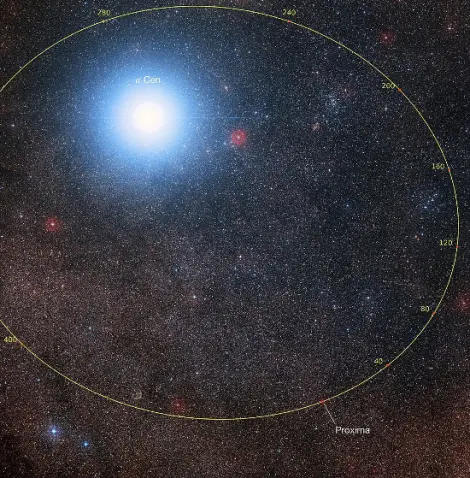
Orbital plot of Proxima Centauri showing its position with respect to Alpha Centauri over the coming millenia (graduations are in thousands of years). The large number of background stars is due to the fact that Proxima Cen is located very close to the plane of the Milky Way. Image: P. Kervella (CNRS/U. of Chile/Observatoire de Paris/LESIA), ESO/Digitized Sky Survey 2, D. De Martin/M. Zamani (CC BY 4.0)
Proxima Centauri has the stellar classification M5.5Ve, indicating a main sequence star appearing reddish in colour. The star has a mass of only 0.1221 solar masses (an eighth of the Sun’s mass or 129 times the mass of Jupiter) and a radius of 0.1542 solar radii (about a seventh of the Sun’s radius). The star’s angular diameter was measured at 1.02 ± 0.08 milliarcseconds in 2002 using optical interferometry with the Very Large Telescope (VLTI).

This diagram illustrates, from left to right, the relative size of the Sun, α Centauri A, α Centauri B and Proxima Centauri. Image: Wikimedia Commons/RJHall (CC BY-SA 3.0)
With a surface temperature of 3,042 K, Proxima shines with only 0.0017 solar luminosities across all wavelengths. Over 85% of the star’s energy output is in the invisible infrared. Visually, Proxima has a luminosity of only 0.0056% that of the Sun. It would only appear as a fifth magnitude star from Alpha Centauri AB despite their proximity.
The Sun’s nearest neighbour is a slow spinner, with a projected rotational velocity under 0.1 km/s. It takes 82.6 ± 0.1 days to complete a rotation. It is a little older than the Sun, with an estimated age of 4.85 billion years. (The Sun is about 4.6 billion years old.)
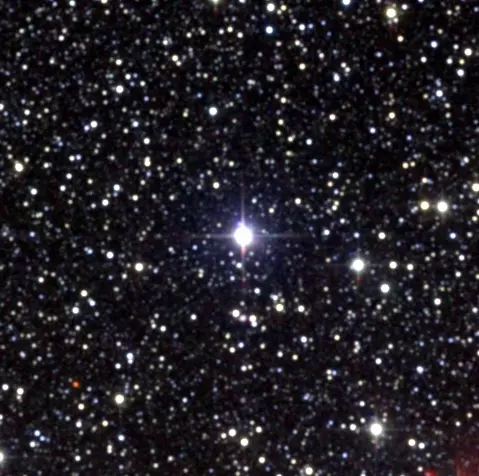
Proxima Centauri, the closest star to Earth other than the Sun, as seen by 2MASS. Atlas Image mosaic obtained as part of the Two Micron All Sky Survey (2MASS), a joint project of the University of Massachusetts and the Infrared Processing and Analysis Center/California Institute of Technology, funded by the National Aeronautics and Space Administration and the National Science Foundation.
Unlike the Sun, which will evolve into a red giant in 6.5 billion years and reach the end of its life at an age of about 10 billion years, Proxima will stay on the main sequence for another four trillion years due to its low mass and low energy production. Since no star that age has ever been observed (because the universe is only about 13.787 billion years old), the future of Proxima and other low-mass red dwarfs – the most common stars in the universe – is uncertain. Stars with a mass of less than 0.25 solar masses do not evolve into red giants. Astronomers believe that, once they are no longer able to sustain nuclear fusion, these stars will remain small and, as the proportion of helium increases, they will grow hotter to become blue dwarfs. Blue dwarfs are purely hypothetical and their future existence is predicted based on evolutionary models. Toward the end of the blue dwarf phase, Proxima will become considerably more luminous, reaching up to 2.5% of the Sun’s luminosity. Once it runs out of hydrogen fuel, it will evolve into a white dwarf, skipping the red giant phase, and gradually lose all its heat energy.
Proxima has the variable star designation V645 Centauri. It is classified as a flare star, a variable star whose brightness can suddenly and unpredictably increase for a few minutes due to magnetic activity in the star’s atmosphere. These stars are also known as UV Ceti variables, after the best-known example, the red dwarf UV Ceti (Luyten 726-8). UV Ceti is located at a distance of 8.73 light years from the Sun in the constellation Cetus. The nearby star Wolf 359, located 7.86 light years away in the constellation Leo, also belongs to this group.
Proxima’s magnetic field is produced by convective heat transfer (mass movement of plasma) throughout the stellar body. The magnetic energy of the field is released through flares that can sometimes grow as large as the star and reach temperatures as high as 27 million K, enough to produce X-rays. Proxima’s flares briefly increase the star’s luminosity and produce a total X-ray output similar to that of the considerably larger Sun. Even Proxima’s quiescent X-ray luminosity is similar to the Sun’s. The star’s activity level has been found to vary over a 442-day period.
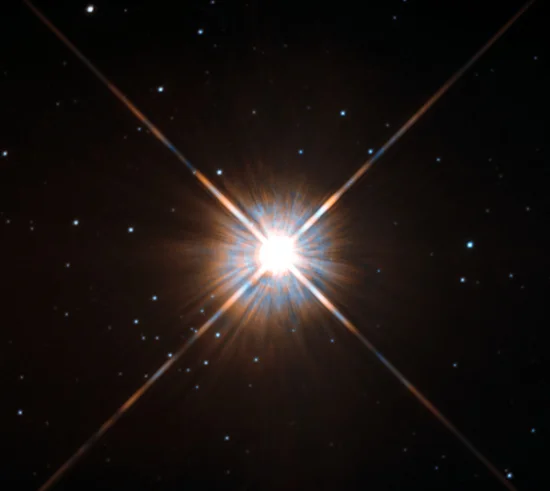
Proxima Centauri (Alpha Centauri C), image: ESA/Hubble & NASA (CC BY 4.0)
A study published in 2000 that used hydrodynamic models to estimate mass-loss rates for Alpha Centauri AB and Proxima Centauri found an upper limit to Proxima’s mass-loss rate of 0.2 solar masses. Since Proxima has a radius of 0.16 solar radii and a surface area about 40 times smaller than the Sun, even though the mass loss value is low, it could be as much as eight times greater than the Sun’s.
A 2016 study found that Proxima has a regular cycle of starspots lasting seven years from peak to peak. The dark spots on the star’s surface are caused by magnetic fields that restrict the flow of plasma and are cooler than the surrounding area. Unlike the Sun, which has more than 100 sunspots on less than 1% of its surface at maximum and almost no spots at the minimum, Proxima has bigger spots relative to its size and they cover a fifth of its surface at once. The discovery came as a surprise because the star is believed to be convective all the way to the core and was not supposed to experience a regular activity cycle.
Distance
Proxima Centauri has been the nearest known star to Earth for about 32,000 years and will stay the nearest star for another 25,000 years. At that point, the two brighter components in the Alpha Centauri system – Rigil Kentaurus and Toliman – will alternate as the nearest star about every 79.91 years, which corresponds to their orbital period.
The currently accepted distance of Proxima Centauri (4.244 light years, or 1.301 parsecs, or 268,400 astronomical units) is based on a parallax of 768.5004 ± 0.2030 milliarcseconds, published in Gaia Data Release 2 in 2018. The Gaia space observatory has been measuring the positions and motions of stars and other astronomical objects since 2013 and will continue to send the most accurate data to date until 2022.
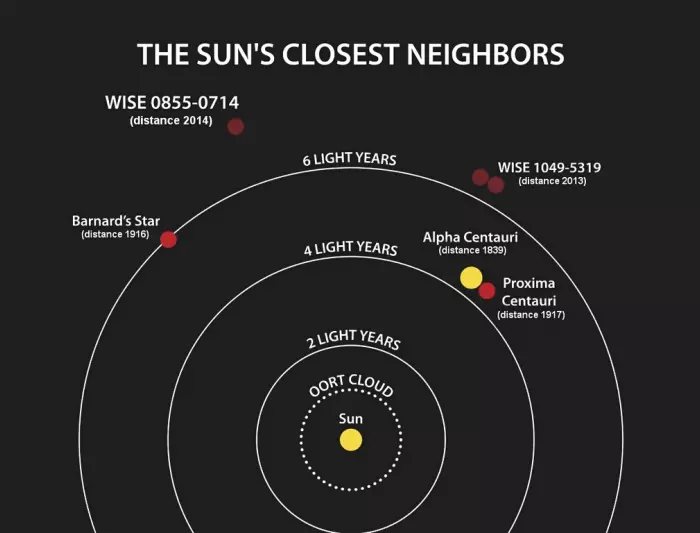
This diagram illustrates the locations of the star systems closest to the sun. The year when the distance to each system was determined is listed after the system’s name. Image: NASA/Penn State University
In recent decades, different values were given for Proxima’s parallax by different sources: the Research Consortium on Nearby Stars (768.13 ± 1.04 mas) in 2014, the Hipparcos Catalogue (772.33 ± 2.42 mas) in 1997, the Hipparcos New Reduction (771.64 ± 2.60 mas) in 2007, and the data from interferometric fringe-tracking astrometry using the Fine Guidance Sensor 3 on the Hubble Space Telescope (768.77 ± 0.37 mas) in 1999.
Proxima Centauri is moving toward the Sun with a radial velocity of -22.204 ± 0.032 km/s. Astrometric measurements using the Hubble Space Telescope have yielded a proper motion of 3.8531 ± 0.0005 arcseconds per year.
Several estimates have been made in recent years about Proxima’s closest approach to the Sun. In 2001, J. García-Sánchez et al. combined the Hipparcos parallax and proper motion data with ground-based radial velocity measurements to predict stellar trajectories, and found that Proxima will come within 3.11 light years of the Sun at its closest approach in about 26,700 years. After perihelion, the star will gradually move farther away.
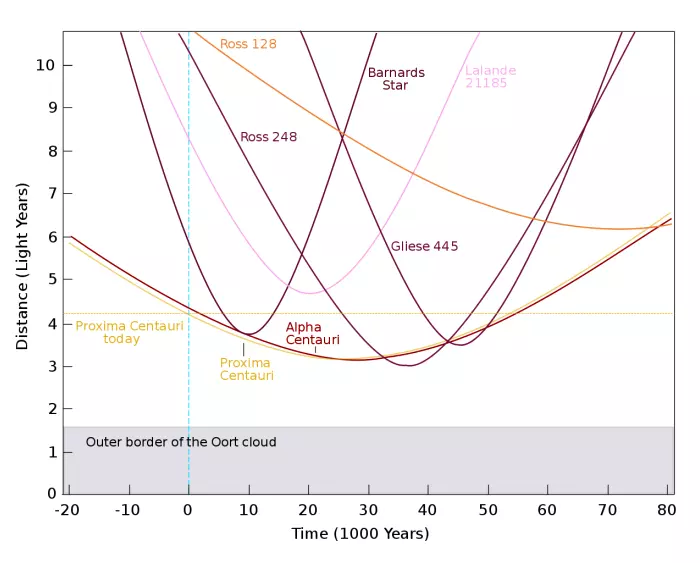
Distance to the nearest stars in a time range between 20,000 years in the past and 80,000 years in the future. Image: Wikimedia Commons/FrancescoA (CC BY-SA 3.0)
In 2010, V. V. Bobylev used more recent Hipparcos data and predicted that Proxima will make the perihelion approach in 27,400 years, when it comes within 2.90 light years of the Sun.
In 2014, C. A. L. Bailer-Jones used the combined Hipparcos and Tycho-2 catalogue data and radial velocity surveys to model stellar encounters and found that the closest approach will occur in about 26,710 years, when Proxima comes within 3.07 light years of the solar system.
A 1998 study investigating galactic orbital parameters of nearby UV Ceti stars found that Proxima orbits through the galaxy with an eccentricity of 0.069, at a distance from the Galactic Centre that varies from 27,000 to 31,000 light years.
Alpha Centauri system
Proxima is the faintest component of the Alpha Centauri system, which also comprises the larger and more massive Rigil Kentaurus (Alpha Centauri A) and Toliman (Alpha Centauri B). Rigil Kentaurus, the primary component, is a solar-like yellow main sequence star of the spectral type G2V and the slightly smaller and less massive Toliman is another hydrogen-fusing dwarf of the spectral type K1V, appearing more orange than Rigil Kentaurus. The two stars are orbiting around a common centre of mass with a period of 79.91 years. They have an eccentric orbit that takes them within 11.2 astronomical units of each other and as far apart as 35.6 astronomical units. Without binoculars they appear as a single star, but can be resolved even in smaller instruments most of the time.
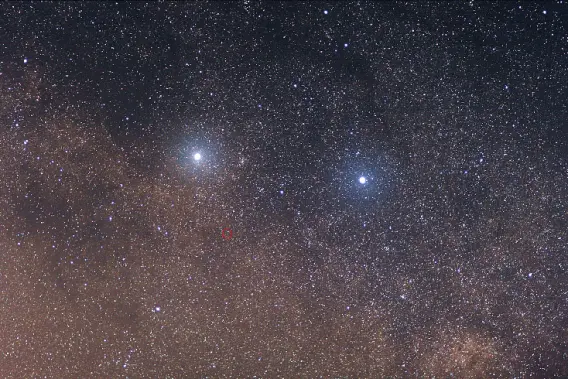
The two bright stars are (left) Alpha Centauri and (right) Beta Centauri, both binaries. The faint red star in the center of the red circle, at right angles to both and southwest of Alpha is Proxima Centauri, intensely red, smaller in size, weaker in brightness and a distant third element in a triple star system with the main close pair forming Alpha Centauri. Image: Wikimedia Commons/Skatebiker (CC BY-SA 3.0)
In 2017, Kervella et al. used HARPS high-precision absolute radial velocity measurements and demonstrated that Proxima and Alpha Centauri were gravitationally bound with a high degree of confidence. Even though the similarity of the stars’ proper motion and parallax had always indicated that they were bound, this had not previously been substantiated with astrometric and radial velocity data that yielded sufficient statistical significance. The study also suggested that Proxima’s orbital motion may have affected planet formation around Alpha Centauri AB, or that Proxima b may have formed as a distant circumbinary planet of Alpha Centauri and was captured by Proxima.
A triple star system like Alpha Centauri can form if a massive binary with a mass of 1.5 to 2 solar masses captures a low-mass star like Proxima before their native star cluster disperses. It is uncertain whether this is what happened in the Alpha Centauri system. If Proxima was bound to the AB binary during the system’s formation, it may have affected the binary’s protoplanetary disks, where planetary systems form. Proxima’s presence would have enriched any Earth-like planets in the dry inner regions with volatile elements, such as water. If Proxima was captured by the binary during a later stage, any planets orbiting it would have been less disrupted by Alpha Centauri AB.
Planets
Proxima Centauri hosts at least three planets. These are the nearest exoplanets to the Sun. Proxima Centauri b (Alpha Centauri Cb), the first planet to be discovered, was announced in 2016. It orbits within Proxima’s habitable zone (0.0423–0.0816 astronomical units). Proxima Centauri c (Alpha Centauri Cc), the second planet, was discovered in 2019 and confirmed in 2020. Proxima c was the first exoplanet to be directly imaged.
An additional signal was found in 2019 by a team using the ESPRESSO instrument (Echelle Spectrograph for Rocky Exoplanet- and Stable Spectroscopic Observations) on the Very Large Telescope in Chile. The signal had a period of 5.15 days, but it may have been statistical noise. If it is a planet, it has a minimum mass of 0.29 ± 0.08 Earth masses.
The discovery of Proxima Centauri d was confirmed on February 10, 2022. With a mass of only 0.26 ± 0.05 Earth masses, it is one of the lightest extrasolar planets ever detected.
Proxima Centauri b
Proxima Centauri b has a mass of at least 1.173 ± 0.086 Earth masses and orbits the host star at a distance of 0.05 astronomical units (7.5 million kilometres). It completes an orbit around the star every 11.218 ± 0.029 days.
The exact mass of the planet is uncertain. The value of 1.173 ± 0.086 Earth masses is based on a nearly edge-on orbit, but the planet’s orbital inclination has not been measured yet. The planet is about 90% likely to have a mass of less than 2.77 Earth masses and its minimum mass is 1.17 Earth masses.
A 2020 study by Kervella et al. estimated a mass of 2.1 Earth masses (1.5 – 4 Earth masses) for Proxima b based on an analysis of the orbital parameters of Proxima c, assuming the coplanarity of the planets’ orbits. Another 2020 study, published by Benedict et al., estimated a mass of 3.0 ± 0.3 Earth masses, also assuming a coplanar system.
The radius of Proxima b is also unknown. If the planet’s density is the same as the Earth’s, it has a radius of at least 1.1 Earth radii. However, if its density is lower or it has a mass higher than the minimum mass, the planet may be larger. Proxima b is more than 10% likely to have an icy composition with a thick hydrogen and helium atmosphere.
The planet is in the star’s habitable zone. Its equilibrium temperature – 234 K (-39° C or -38°) – is in the range where liquid water could exist of the planet’s surface. It is slightly colder than the Earth’s (255 K, -18° C, or -1° F). However, whether the planet could harbour life has been the subject of debate. It is exposed to stellar wind pressures over 2,000 times stronger than those experienced by Earth. Additionally, Proxima b is likely tidally locked to its host star, showing only one face toward the star, much like the same side of the Moon always faces the Earth. This means that most of the planet’s surface probably experiences either day or night all the time and habitable areas would probably exist only in the border region (known as the terminator line or the twilight zone) between the very hot and very cold sides, where temperatures may make it possible for liquid water to exist. If the planet had an atmosphere, it could redistribute the energy from the star-facing side to the far side. However, orbiting a flare star, the planet’s atmosphere may have been stripped a long time ago. Proxima b is flooded with ultraviolet light and X-rays, which would be fatal to life on the surface. However, life could exist under the surface.
Proxima b gets only about 3% of the photosynthetically active radiation from its host star in the visible spectrum that Earth gets from the Sun (comparable to the 3.7% that Jupiter gets), which means that it is normally not much brighter than twilight on the planet’s surface. Most of the radiative flux from Proxima is in the infrared spectrum. The planet gets only 65% of the flux from Proxima that the Earth gets from the Sun. However, since Proxima b orbits its host star at only a twentieth of the distance from the Earth to the Sun, it gets about 400 times more X-ray radiation than Earth.
The existence of Proxima b was first suspected in 2013, when a signal was detected by Mikko Tuomi of the University of Hertfordshire in Hatfield, UK, while researching archival data obtained with the Very Large Telescope in Chile between 2003 and 2009.
The planet was discovered by an international team led by Guillem Anglada-Escudé of Queen Mary University of London. The team used data obtained by the HARPS (High Accuracy Radial velocity Planet Searcher) spectrograph at the ESO 3.6m telescope at La Silla Observatory and UVES (Ultraviolet and Visual Echelle Spectrograph) on the Very Large Telescope at Paranal Observatory in Chile.
The existence of Proxima b was confirmed on August 24, 2016 in an article in Nature. The planet was discovered using the radial velocity method. It was reported to have a minimum mass of about 1.3 Earth masses and a semi-major axis of about 0.05 astronomical units, placing it right in the centre of Proxima’s habitable zone. The same team found signs of another planet, a super-Earth, with an orbital period between 60 and 500 days.
Several campaigns were undertaken to search for a transit of the planet, which would allow scientists to accurately measure the planet’s mass and radius and to study its atmospheric properties. A team using the Bright Star Survey Telescope at the Chinese Zhongshan Station in Antarctica identified a transit-like signal on September 8, 2016.
However, a study published in May 2019 that used data obtained with the Spitzer Space Telescope ruled out planetary transits, attributing previously witnessed transit-like events to residual correlated noise resulting from Proxima’s flaring and activity patterns.
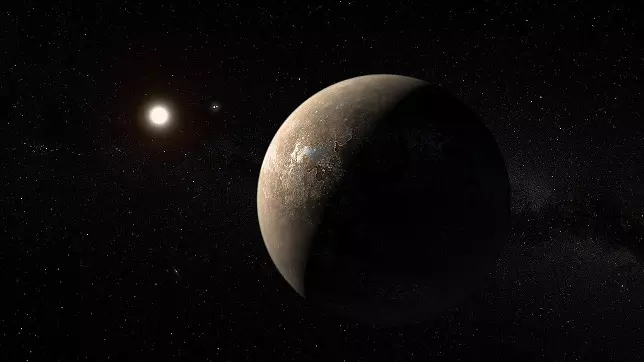
Artist’s impression of the exoplanet Proxima Centauri b shown as of an arid (but not completely water-free) rocky Super-Earth. This appearance is one of several possible outcomes of current theories regarding the development of this exoplanet, while the actual look and structure of the planet is known in no ways at this time. Proxima Centauri b is the closest exoplanet to the Sun and also the closest potentially habitable exoplanet as well. It orbits Proxima Centauri, a red dwarf with a surface temperature of 3040 K (thus hotter than light bulbs and therefore whiter, as depicted here). The Alpha Centauri binary system is shown in the background. Image: ESO/M. Kornmesser (CC BY 4.0)
Proxima Centauri c
Proxima Centauri c is a super-Earth that orbits Proxima Centauri at a distance of about 1.489 ± 0.049 astronomical units (220 million kilometres), completing an orbit every 1,928 ± 20 days (5.28 years). It has about 7 Earth masses and is about as distant from Proxima b as Neptune is from Earth.
With an orbital distance of 1.5 AU and an equilibrium temperature of only about 39 K (-234° C or -390 F), Proxima c is most likely unhabitable.
Proxima c was first discovered in April 2019 by a team led by Italian astrophysicist Mario Damasso of the Astrophysical Observatory of the National Institute for Astrophysics (INAF) in Turin, Italy. The team found minor movements of Proxima Centauri in the radial velocity measurements made by the HARPS spectrograph, which indicated another candidate planet.
The existence of Proxima c was confirmed in 2020 using 25-year old data obtained by the Hubble Space Telescope in 1995. Fritz Benedict, an emeritus Senior Research Scientist with McDonald Observatory at The University of Texas at Austin, had collected the Hubble data using Hubble’s Fine Guidance Sensors (FGS) for his own studies of Proxima Centauri in the 1990s. At the time, he was looking for planets with orbital periods of less than 1,000 days. When he revisited the data in 2020, he found a planet with an orbital period of about 1,907 days.
Images of Proxima Centauri c at several points during its orbit were subsequently published by a team led by Raffaele Gratton of INAF. The images were obtained with the SPHERE instrument on the Very Large Telescope. Using his own astrometric data from the 1990s, the radial velocity studies by Damasso and Gratton’s images of the planet, Benedict derived a mass of about 7 ± 1 Earth masses for Proxima c.
Gratton and his team searched for an optical counterpart of Proxima c in the SPHERE images and, while they were unable to confirm a detection, they found a possible candidate. However, the object was too bright and if it was Proxima c, it may have a conspicuous ring system with a radius of about 5 Jupiter radii. The brightness may also be due to dust produced by collisions with satellites or it may be evaporating dust increasing the planet’s luminosity.
Proxima Centauri d
The discovery of Proxima Centauri d was announced on February 10, 2022. The planet was detected using the Echelle SPectrograph for Rocky Exoplanets and Stable Spectroscopic Observations (ESPRESSO) on ESO’s Very Large Telescope (VLT). The planet orbits Proxima Centauri from a distance of 0.0289 ± 0.0002 astronomical units (4 million kilometres) with an eccentricity of 0.04. It takes about 5.122 days to complete an orbit. With a mass only 25% that of Earth, it is one of the lightest planets ever discovered.
The existence of Proxima d was confirmed by measuring the wobble of its parent star. The planet is so small that the effect of its gravity only causes Proxima to wobble at about 40 centimetres per second (1.44 km per hour).
Proxima d orbits at a distance less than a tenth that of Mercury’s distance from the Sun, which puts it between the host star and the habitable zone. This makes it very unlikely that liquid water may exist on the planet’s surface.

This artist’s impression shows a close-up view of Proxima d, a planet candidate recently found orbiting the red dwarf star Proxima Centauri, the closest star to the Solar System. The planet is believed to be rocky and to have a mass about a quarter that of Earth. Two other planets known to orbit Proxima Centauri are visible in the image too: Proxima b, a planet with about the same mass as Earth that orbits the star every 11 days and is within the habitable zone, and candidate Proxima c, which is on a longer five-year orbit around the star. Image: ESO/L. Calçada (CC BY 4.0)
Facts
Seen from a planet orbiting Proxima Centauri, the night sky would not be significantly different from ours, except the bright Alpha Centauri AB pair would appear like a close double – easily resolved without binoculars most of the time – with a combined visual magnitude of -6.8. Rigil Kentaurus would have an apparent magnitude of -6.5 and Toliman, -5.2.
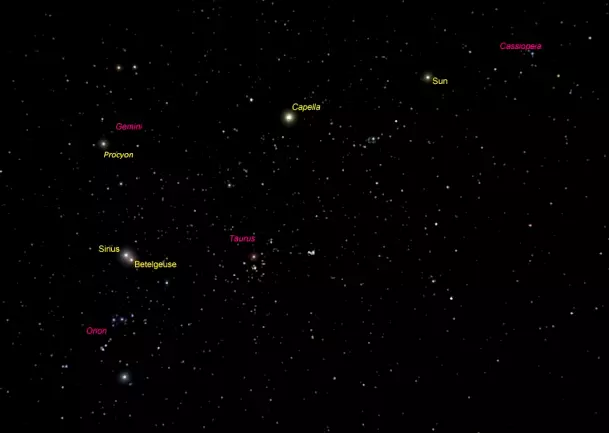
The sky from Alpha Centauri, image: Wikimedia Commons/Skatebiker (CC BY-SA 3.0)
The Sun would appear as a first-magnitude star with an apparent magnitude of 0.47 in the constellation Cassiopeia, near Segin and in the same line of sight as the Heart Nebula. The Sun would give Cassiopeia’s W a /W shape. It would appear about as bright as Achernar, the ninth brightest star in the sky, appears from Earth. Sirius would appear slightly fainter than it does from Earth, at magnitude -1.2, and it would be separated from Betelgeuse by less than a degree. Procyon would appear in the constellation Gemini and not in Canis Minor, as it does when seen from Earth.
Proxima Centauri was discovered by the Scottish astronomer Robert T. A. Innes in 1915. Innes made his observations from the Union Observatory in Johannesburg, South Africa, using a 9-inch refractor and a 10-inch astrographic camera given to him by astrophotography pioneer John Franklin-Adams. He found a star more than 2 degrees distant from Alpha Centauri that shared the same proper motion. While he was unable to measure its distance accurately, he believed that the star was closer to the solar system than Alpha Centauri. He named it Proxima Centaurus.
In 1917, the Dutch astronomer Joan Voûte calculated the trigonometric parallax of Proxima at 0.755″ ± 0.028″ and announced that both its parallax and proper motion were in close agreement with those of Alpha Centauri, concluding that the stars were at the same distance from the Sun.
In 1928, the American astronomer Harold Lee Alden measured the distance of Proxima from the Yale University Observatory in Johannesburg, confirming Innes’ belief that the star was closer to us than Alpha Centauri, whose two components were at the time believed to be the nearest stars to the Sun. Alden found that Proxima was separated by 2° 10’ 49’’ from the centre of mass of Alpha Centauri AB at a position angle of 211°38’.1, which yielded a physical separation of 14,000 astronomical units. He measured the star’s parallax at 0.783″ ± 0.005″.
Proxima Centauri was discovered to be a flare star by the American astronomer Harlow Shapley in 1951. Shapley studied past photographic plates and found that the star was brighter than average on 8% of them by a distinctly measurable amount. At the time, this made Proxima the most active flare star known. The star’s brightest recorded maxima (brightness peaks) indicated that its brightness varied with an amplitude of at least one magnitude.
The massive flares of Proxima Centauri have been observed with the Einstein Observatory (X-ray space telescope), which recorded an X-ray energy curve of the star’s flare in 1980, and later with the EXOSAT and ROSAT satellites, as well as with the XMM-Newton and Chandra X-ray space observatories.
The first known superflare from Proxima was recorded in March 2016 by the Evryscope, an array of telescopes that form a single gigapixel-scale telescope that continuously monitors all of the accessible sky. The superflare increased the star’s optical brightness by a factor of 68 and Proxima briefly shone at magnitude 6.8 or brighter, almost reaching the limit of unaided eye visibility (mag. 6.5). The superflare lasted about an hour and was followed by three weaker flares.
The largest flare recorded was reported in April 2021. A team of researchers led by Meredith A. MacGregor used nine telescopes, including the Atacama Large Millimeter/submillimeter Array (ALMA), NASA’s Transiting Exoplanet Survey Satellite (TESS), the Australian Square Kilometre Array Pathfinder (ASKAP radio telescope), and the Hubble Space Telescope, to observe Proxima for a total of 40 hours from April to July 2019. On May 1, 2019, they detected a superflare that lasted for less than 10 seconds and was mainly visible in ultraviolet wavelengths. The flare caused the star to become 14,000 times brighter than normal in the ultraviolet band. Unlike solar flares, the flare on Proxima produce a huge surge of ultraviolet light and radio waves, also known as “millimeter radiation.”
Such events pose a large threat to the habitability of Proxima b and any other planets orbiting M-type flare stars. They make the existence of alien life unlikely. Even if Proxima b had an ozone layer that could protect it from the strong UV radiation of a single superflare, it would take years for the ozone layer to recover. If such intense flares occur at a relatively high rate, this can prevent the formation of an ozone layer altogether, leaving the planet’s surface exposed to high UV radiation levels. Even if the planet’s atmosphere survives the stellar activity, any life on the planet’s surface would need to undergo complex adaptations to survive. In the period from January 2016 to March 2018, the Evryscope recorded 24 flares from the star with bolometric energies from 1030.6 to 1033.5 erg, indicating that there are at least 5.2 events with a bolometric energy of 5.2 1033 erg per year. The study used photochemical modelling that demonstrated a 90% ozone destruction within five years as a result of the superflare and the star’s regular activity.
On April 22 and 23, 2020, the New Horizons interplanetary space probe was used in conjunction with ground-based telescopes to take pictures of Proxima Centauri and Wolf 359, another nearby red dwarf (7.86 ly). The space-based and Earth-based images, taken from vantage points about 6.9 billion kilometres apart, were compared to demonstrate an easily observable stellar parallax. Launched in 2006, the New Horizons probe had made its way to the outer edge of the solar system when the pictures were taken.
Alpha and Proxima Centauri share a common proper motion with six other stars, two binary systems and a triple star system. The stars’ space velocities are within 10 km/s of Alpha Centauri’s peculiar velocity. This indicates that all the stars may have formed in the same molecular cloud and form a moving group.
The proximity of the Alpha Centauri system to Earth has made it the target for several interstellar exploration missions. With the existing propulsion technologies, a spacecraft would take thousands of years to reach the system. The technologies and propulsions methods that would reduce travel time have not been developed yet, but several projects were launched in recent decades that made Alpha Centauri and Proxima in particular the targets for the first interstellar travel program.
The most recent of these, Breakthrough Starshot, was announced on April 12, 2016. Launched by the physicist and entrepreneur Yuri Milner, physicist Stephen Hawking, and internet entrepreneur Mark Zuckerberg, the project entails developing a fleet of a thousand centimetre-sized solar sail spacecraft, each equipped with four cameras, that would travel to the Alpha Centauri system. The concept involves launching a mothership that would carry these spacecraft, named StarChips, to high-altitude Earth orbit, from where they would be accelerated using lasers. The propulsion method would enable the StarChips to travel at a speed between 15% and 20% of the speed of light, reducing travel time to only 20-30 years. The return message would only take 4.22 years to reach Earth. Breakthrough Initiatives estimates that the first spacecraft may launch around the year 2036.
On July 26, 2017, they announced that Breakthrough Starshot successfully flew its first precursors to StarChip probes, named Sprites, on June 23. The world’s tiniest fully functional space probes were 3.5-by-3.5 centimetres in size and equipped with computers, sensors, radios and solar panels.
Once the existence of Proxima Centauri b was confirmed in August 2016, the goal of the project became more specific: a flyby mission to Proxima b. Additionally, Breakthrough Initiatives started collaborating with the European Southern Observatory on a planet-searching mission in the habitable zones of Alpha Centauri.
Proxima Centauri is also a SETI (search for extraterrestrial intelligence) target. One of the projects aiming to search for intelligent life outside the solar system, named Breakthrough Listen, was launched in 2015 to actively search for signs of alien communications. Based at University of California, Berkeley, Breakthrough Listen is collaborating with the TESS team (Transiting Exoplanet Survey Satellite) to look for advanced civilizations outside the solar system. As part of the collaboration, thousands of planets detected by TESS are scanned for technosignatures by the Breakthrough Listen team. In 2020, a candidate signal – Breakthrough Listen Candidate 1 (BLT1) was picked up that appeared to originate from Proxima, but it turned out to be a product of terrestrial interference. Radio signals from Earth-based technology make the search challenging.
As the nearest star to Earth, Proxima has been used or referenced in countless works of fiction. Notable uses in literature include the short story “Proxima Centauri” (1935) by Murray Leinster, the novella “The Variable Man” (1953) by Philip K. Dick, and the novels The Magellanic Cloud (1955) by Stanislaw Lem, Orphans of the Sky by Robert A. Heinlein (1963), The Three Stigmata of Palmer Eldritch (1965) by Philip K. Dick, Captive Universe (1969) by Harry Harrison, Stewart Cowley’s Terran Trade Authority (1978–1980) novels, Yaana (2014) by S. L. Bhyrappa, and Traitor (2019) by J. F. R Coates.
The star has also been referenced in the films Moscow-Cassiopeia (1973), directed by Richard Viktorov, Event Horizon (1997) by Paul W. S. Anderson, Próxima (2007) by Carlos Atanes, and in the television series Babylon 5 (1993-98), “The Waters of Mars” (2009) special of Doctor Who, and Ascension (2014).
Name
The name Proxima Centauri (pronunciation: /ˈprɒksɪmə sɛnˈtɔːraɪ/) means “the nearest (star) of Centaurus.” It was given to the star by the Scottish astronomer Robert T. A. Innes, who discovered it in 1915. Innes named it Proxima Centaurus and, as the name became widely adopted, Centaurus was changed to the genitive form, Centauri.
The name was formally approved by the International Astronomical Union’s (IAU) Working Group on Star Names (WGSN) on August 21, 2016.
Location
Proxima Centauri is challenging to find because, at magnitude 11.13, it is too dim to be visible to the unaided eye. It requires a 3-inch or larger telescope to be seen. The star lies 2.18 degrees (four full Moons) southwest of the Alpha Centauri binary pair. With a declination of –62° 40’, it never rises above the horizon from locations north of the latitude 27° N.
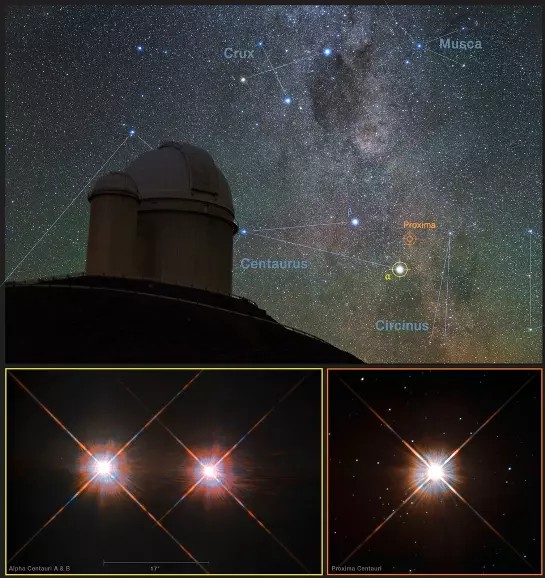
This picture combines a view of the southern skies over the ESO 3.6-metre telescope at the La Silla Observatory in Chile with images of the stars Proxima Centauri (lower-right) and the double star Alpha Centauri AB (lower-left) from the NASA/ESA Hubble Space Telescope. Proxima Centauri is the closest star to the Solar System and is orbited by the planet Proxima b, which was discovered using the HARPS instrument on the ESO 3.6-metre telescope. Image: ESO, August 24, 2016. (CC BY 4.0)
Constellation
Proxima Centauri is located in the constellation of Centaurus. Centaurus is the ninth largest constellation in the sky, stretching across an area of 1,060 square degrees. It is also one of the brightest constellations. It contains 10 stars brighter than magnitude 3.00, including the third and 11th brightest stars in the sky, Alpha and Beta Centauri. The constellation is also home to the white dwarf popularly known as the Diamond Star or Lucy.
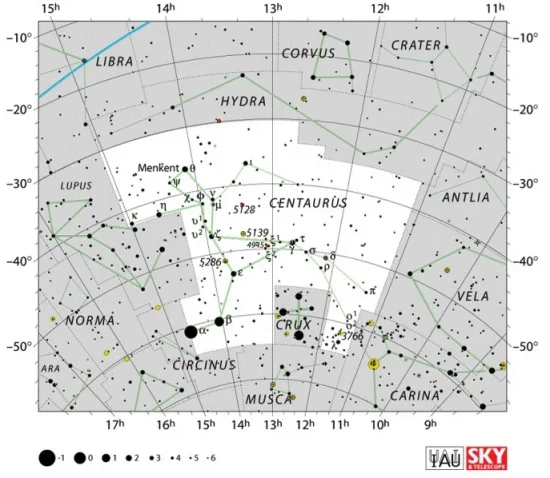
Centaurus constellation map by IAU and Sky&Telescope magazine
Representing a centaur in Greek mythology, Centaurus is one of the Greek constellations, first listed by Ptolemy of Alexandria in his Almagest in the 2nd century CE. It is one of the southern circumpolar constellations, visible throughout the year in the southern hemisphere. However, due to its location in the far southern sky, most of its stars are invisible to observers in mid-northern latitudes.
The constellation is home to many well-known deep sky objects. These include the starburst galaxy Centaurus A (mag. 6.84), the elliptical galaxy NGC 4696, the irregular galaxy NGC 5253, the spiral galaxies NGC 4945 and NGC 4622, the polar-ring lenticular galaxy NGC 4650A, the Running Chicken Nebula (Lambda Centauri Nebula, IC 2944), the Boomerang Nebula (ESO 172-7), the Blue Planetary Nebula (NGC 3918), the open clusters NGC 3766 and NGC 5460, and Omega Centauri, the brightest (mag. 3.9), largest and most massive globular cluster known in our galaxy.
The best time of year to see the stars and deep sky objects of Centaurus is during the month of May, when the constellation is particularly prominent in the evening sky. Centaurus is visible in its entirety from locations between the latitudes 25° N and 90° S.
The 10 brightest stars in Centaurus are Alpha Centauri (mag. -0.27), Hadar (Beta Cen, mag. 0.61), Menkent (Theta Cen, mag. 2.06), Gamma Centauri (mag. 2.17), Epsilon Centauri (mag. 2.30), Eta Centauri (mag. 2.35), Leepwal (Zeta Cen, mag. 2.55), Delta Centauri (mag. 2.57), Kulou (Iota Cen, mag. 2.73), and Lambda Centauri (mag. 3.13).
Proxima Centauri – Alpha Centauri C
| Spectral class | M5.5Ve |
| Variable type | UV Ceti |
| U-B colour index | 1.26 |
| B-V colour index | 1.82 |
| V-R colour index | 1.68 |
| R-I colour index | 2.04 |
| J-H colour index | 0.522 |
| J-K colour index | 0.973 |
| Apparent magnitude (V) | 10.43 – 11.11 |
| Apparent magnitude (U) | 14.21 |
| Apparent magnitude (B) | 12.95 |
| Apparent magnitude (V) | 11.13 |
| Apparent magnitude (R) | 9.45 |
| Apparent magnitude (I) | 7.41 |
| Apparent magnitude (J) | 5.357 ± 0.023 |
| Apparent magnitude (H) | 4.835 ± 0.057 |
| Apparent magnitude (K) | 4.384 ± 0.033 |
| Absolute magnitude | 15.60 |
| Distance | 4.244 ± 0.001 light years (1.3012 ± 0.0003 parsecs) |
| Parallax | 768.5004 ± 0.2030 mas |
| Radial velocity | −22.204 ± 0.032 km/s |
| Proper motion | RA: −3781.306 mas/yr |
| Dec.: 769.766 mas/yr | |
| Mass | 0.1221 ± 0.0022 M☉ |
| Luminosity (bolometric) | 0.0017 L☉ |
| Luminosity (visual, LV) | 0.00005 L☉ |
| Radius | 0.1542 ± 0.0045 R☉ |
| Temperature | 3,042 ± 117 K |
| Metallicity | 0.21 dex |
| Age | 4.85 billion years |
| Rotational velocity | < 0.1 km/s |
| Rotation | 82.6 ± 0.1 days |
| Surface gravity | 5.20 ± 0.23 cgs |
| Constellation | Centaurus |
| Right ascension | 14h 29m 42.9451234609s |
| Declination | −62° 40′ 46.170818907″ |
| Names and designations | Proxima Centauri, Alpha Centauri C, α Cen C, V645 Centauri, HIP 70890, GJ 551, LTT 5721, NLTT 37460, PLX 3278.00, CCDM J14396-6050C, LPM 526, LHS 49, LFT 1110, IRAS 14260-6227, 2MASS J14294291-6240465, Gaia DR2 5853498713160606720 |